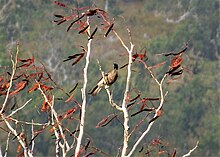| New Guinea friarbird | |
|---|---|

| |
| Conservation status | |
 Least Concern (IUCN 3.1) | |
| Scientific classification | |
| Domain: | Eukaryota |
| Kingdom: | Animalia |
| Phylum: | Chordata |
| Class: | Aves |
| Order: | Passeriformes |
| Family: | Meliphagidae |
| Genus: | Philemon |
| Species: | P. novaeguineae |
| Binomial name | |
| Philemon novaeguineae (Müller, S, 1842) | |
The New Guinea friarbird (Philemon novaeguineae), also known as the Papuan friarbird, is a bird in the Meliphagidae, or honeyeater family. Many taxonomists consider it to be a subspecies of the helmeted friarbird, although some consider it to be a distinct species.
Distribution and habitat
It is found in northern Australia and New Guinea. Its natural habitat is subtropical or tropical moist lowland forests.
Diet
It is one of few species of birds known to partake in extrafloral nectar feeding: it eats sugar secretions from mangroves' shoot bud bases.
References
- PEMBERTON, Robert W.; ONO, Mikio (1993). "Extrafloral Nectar Feeding by the Japanese White-eye". Tropics. 2 (3): 183–186. doi:10.3759/tropics.2.183. ISSN 0917-415X.
- BirdLife International 2004. Philemon novaeguineae. 2006 IUCN Red List of Threatened Species. Downloaded on 26 July 2007.
| Taxon identifiers | |
|---|---|
| Philemon buceroides novaeguineae | |
This article about a honeyeater is a stub. You can help Misplaced Pages by expanding it. |